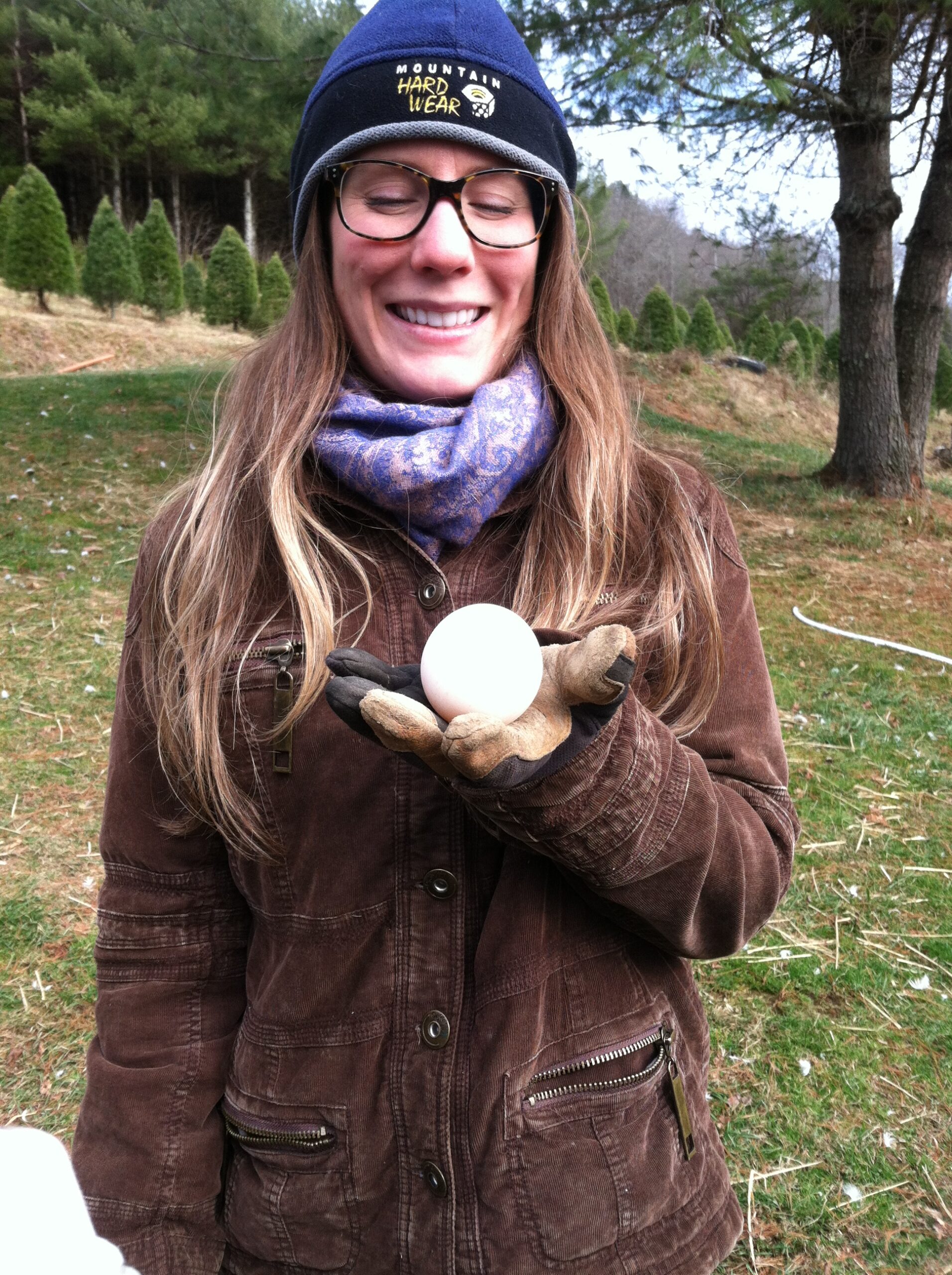Hello.
Heather reporting.
With Grow Appalachia funding, our program purchased ducks for a family this past spring–16 ducks, a mix of white Pekings, blue Swedish, and Indian runners. It was unknown to me what sexes were represented. The clerk at Lights Milling, and the website Mt. Healthy Hatcheries, claimed sexing ducklings was near impossible.
Now that the ducks are grown I am told the tail feathers curl up at the end on the males. If this is truth there are 3 males and 5 females. Online sources confirmed this, and it is also further elucidated by the duck’s behavior. Yes, there was a 50% casualty rate.
These rough-in-tumble eight poultry peeps needed to be transported to a new home yesterday, and it is currently a strange November week of low twenties to teens, freezing rains and sleets, and general coldness.
I definitely did not want to end up with any frozen ducks, sad duck injuries and noises, or PETA stalkers and shouters.
To take us back a step, these ducks were not put through the best beginnings. Six ducklings were killed when the caretaker did not place their stepping-stone back into their pool after rinsing the pool out. Baby ducklings cannot hop very far nor can they swim very long, If they get tired and cannot get out of the water, they will drown. 🙁
Whatever your stance on animal/human interactions, or your stance on the sanctity of life, I should hope we can all agree that when we choose to engage in animal husbandry, these domesticated beings, who have evolved through years of breeding and training under the not-so-invisible hand of human influence–are at our mercy, and at the mercy of all our carelessness, foolhardiness, forgetfulness, sleepiness, and above all, ignorance. Not many people, thankfully, want to kill a duckling on purpose, and waste life in this way. But it still sad when an accident like the stepping-stone one occurs.
The ten remaining ducks continued to flourish, but it became very clear they could not be raised identical to chickens.
First and foremost, they are WATER FOWL. This means they want a pool, a pond, a creek, anything to safely jump around in, splash in, gargle with, float on, clean with, and live. Do not place a pool inside their coop, as they will splash everywhere and create a sopping mess that needs to be cleaned out much more frequently then is reasonable. Place any pools in their fenced-in paddock.
They will also waste a lot of drinking water if allowed to play in it. Make sure there is play-water available outside, some sort of flat pan/dish of plastic or metal for them to wash their heads in, and that their drinking water is elevated off the ground, no higher than duck back level.
Do not let ducks free-range at night unless you meet the following criteria:
Living in an area with absolutely no mammalian predators–raccoon, foxes, coyotes, kingfishers, dogs, cats, and any other furred-creature I can’t think of right now.
Birds of Prey are an issue, but only when the ducks are small enough to be picked up. Post-duckling size, this should not be an issue.
Living in an area with a large body of water that would allow ducks to float out of reach of non-swimming predators.
Remember that ducks, such as common egg-layers purchased in hatcheries, farm stores, and feed stores, are domesticated. They do not have the ability to fly very high or far, and have lost many of the defenses their wild ancestors possess.
More wild-ish ducks such as Muscovy could fly away.
On the note of what not to do, the remaining 10 adult ducks were passed on to another caretaker on the same property. They were cruising around the whole place at night, until two of them, the two smallest ones, where found with broken necks. A few other ducks were injured but survived. After the incident the ducks were shut inside the coop at night.
I know we all want our animals to roam wild and free. But lets be real about what our gaggle’s abilities are.
In any event, the newest owners of the now eight ducks did not feel they could financially provide for the ducks during the winter, and they were not interested in selling or consuming eggs, having recently converted to veganism. They cared for the ducks very deeply, as pets.
I was sorry for this whole misunderstanding. I did not have the foresight to create and sign a contract with any of these folks, or have the foresight to be clear on what this poultry grant would pay for and what it would not. The situation was muddied.
I want the ducks to be with a gardener in the program who is interested in working with the ducks responsibly–financially and health and safety wise, while actually benefiting from their presence, through eating and selling eggs, producing more ducklings, slaughtering males, and more. Again, from my mistakes, the ducks suffered.
I knew that our youngest gardener in the program, recent college-graduate Kyle,
had recently rented a house on a 33-acre farm. He had the option to use some land for vegetables and to use an old chicken coop with fenced in paddock that could fit about 50 chickens…or 8 ducks. The coop had not been used in twenty years.
Kyle is probably about twenty years in the wrong time zone himself. A 40-something year-old, fiercely independent and working-horse NewFoundlander in the body of a 20-something year-old, Kyle recently moved out of his apartment, took a step away from college life, and became a house-renter with his partner Nicole. (Featured at beginning of post holding a dinosaur egg.)
When he heard from me that the ducks needed a home, and needed caretakers with a feeding plan/budget, a desire to utilize the ducks to improve their lives nutritionally and/or financially, as well as educationally (taking proper care of ducks requires research and attention), Kyle was interested. He and Nicole crunched some numbers, did some research, and talked it over with me. The ducks have been moved, the the back of a truck in huge plastic dog crates, and a written contract is pending our detailed discussions.
I’ve attached a PDF I found detailing how to transport your ducks without killing them, and/or damaging their retail value and show value. I was worried about the ducks getting too cold in the windy truck bed, but the document informed me they would be okay in a crate with a solid top and air holes on the sides. We faced the caged-front of the dog kennel to the cab, and wind was minimized.
“Transporting Poultry in a Humane Manner”
Phillip J. Clauer, Poultry Extension Specialist , Animal and Poultry Sciences
http://pubs.ext.vt.edu/2902/2902-1088/2902-1088_pdf.pdf
We also split the ducks up between two crates so they had adequate breathing room and would be less likely to fight.
There is obviously a lot more too this, and a lot more coming, but for now, that’s it that’s all.




Leave A Comment